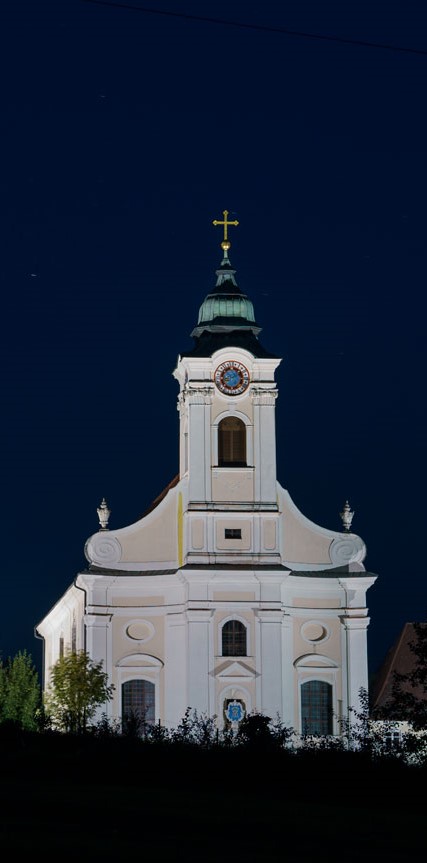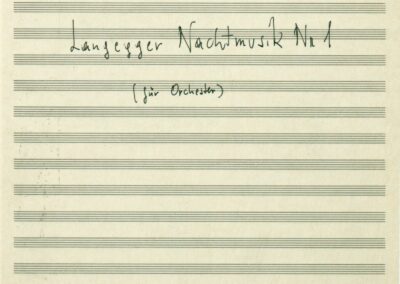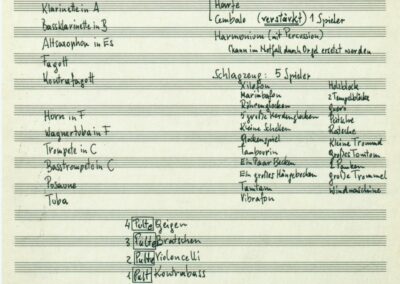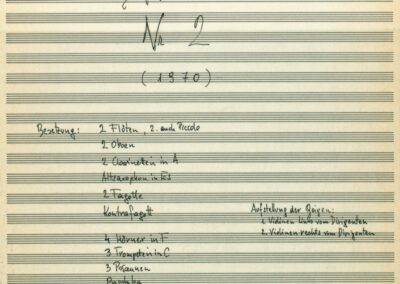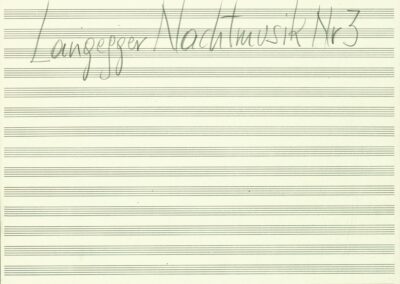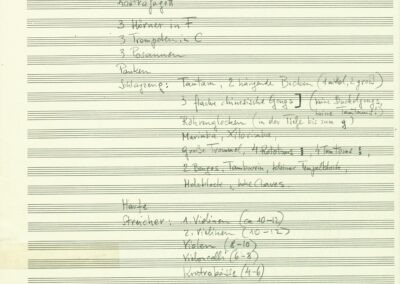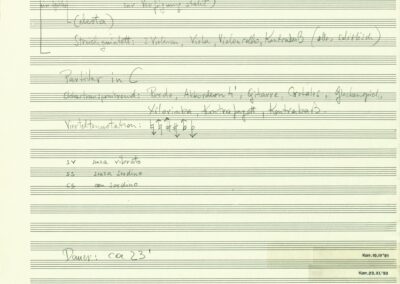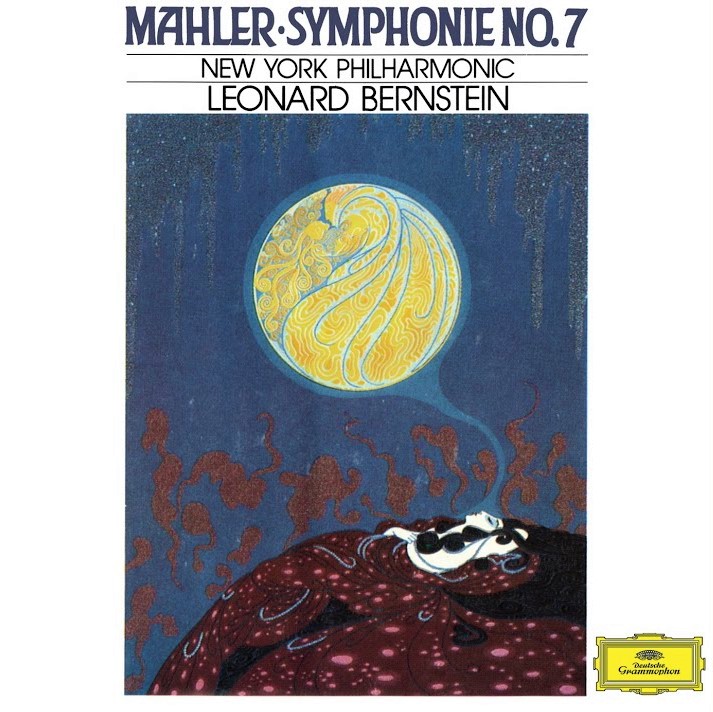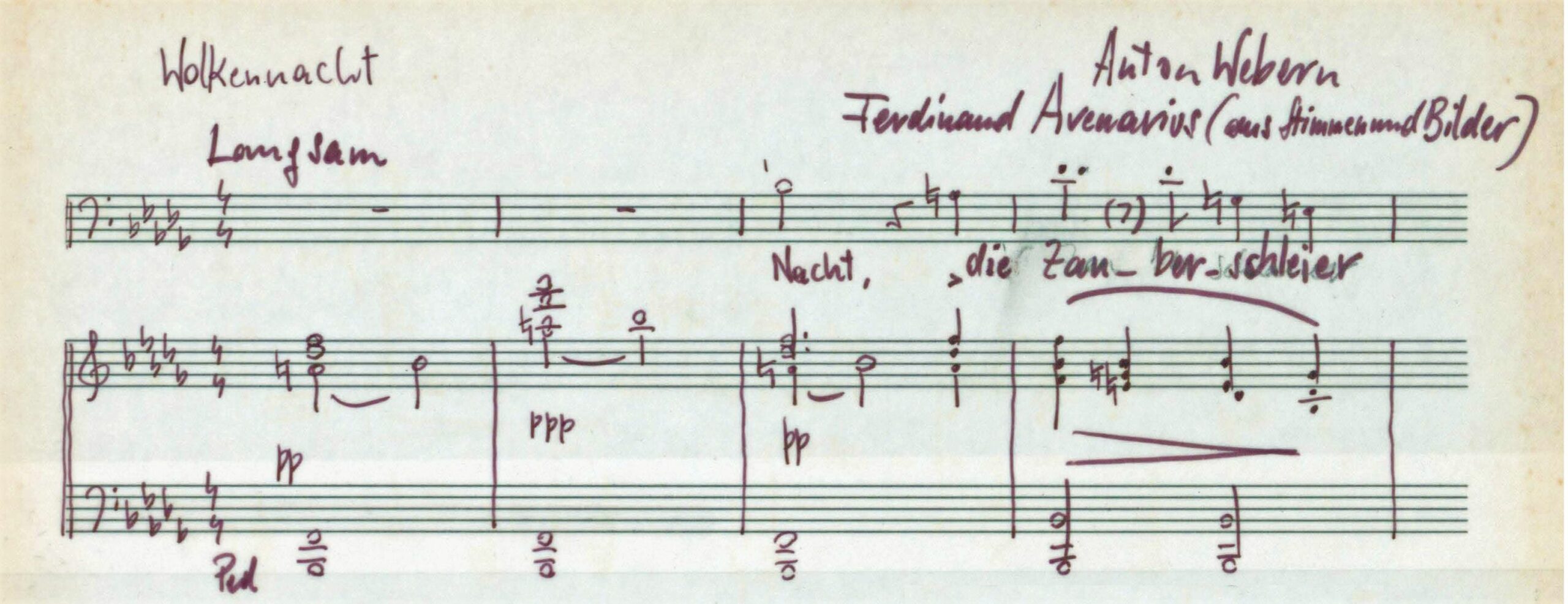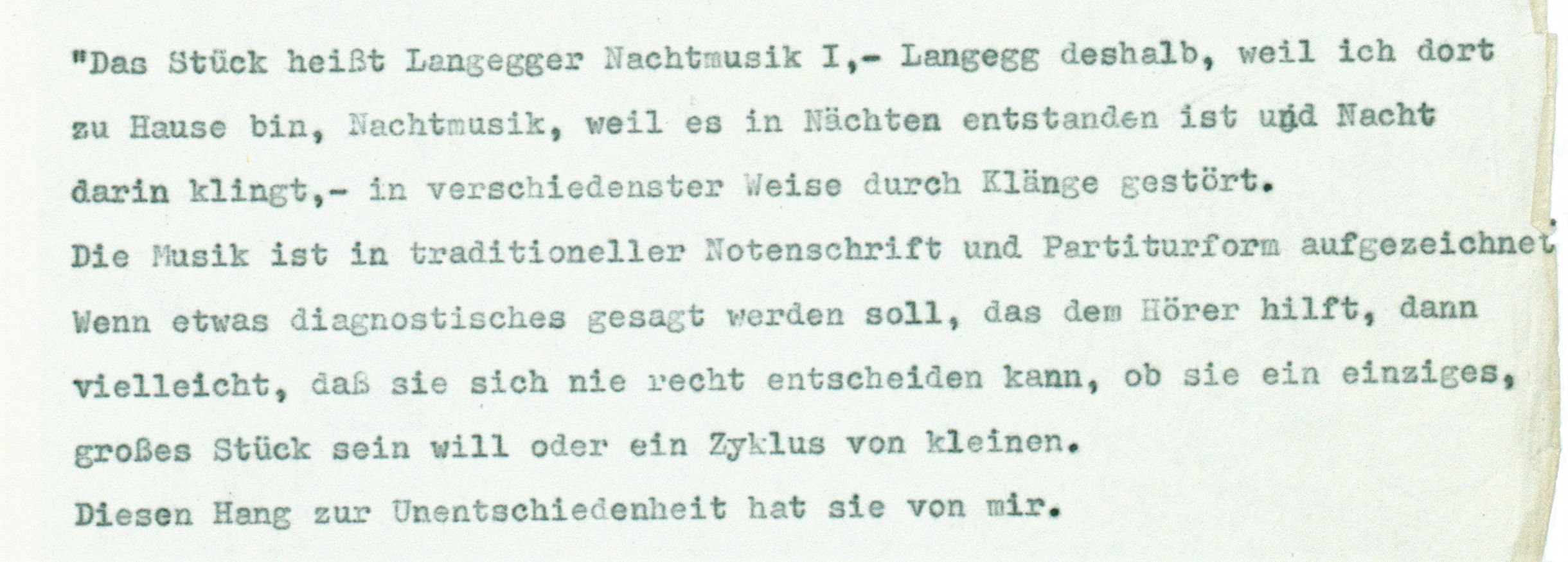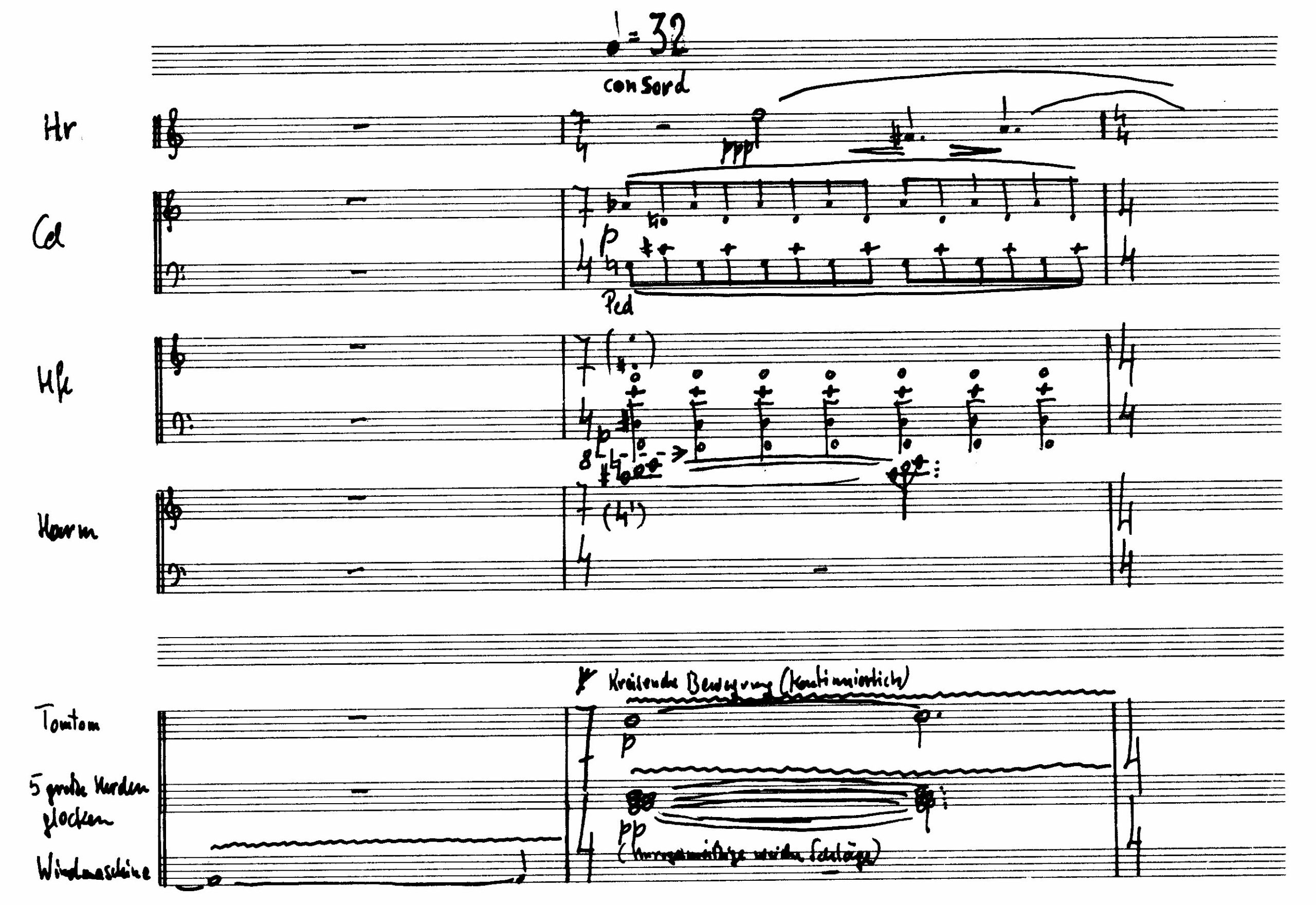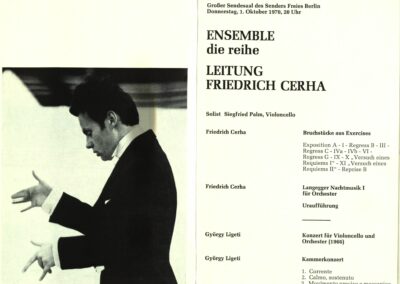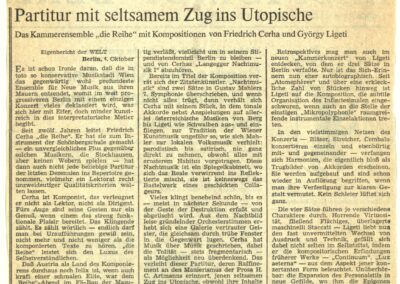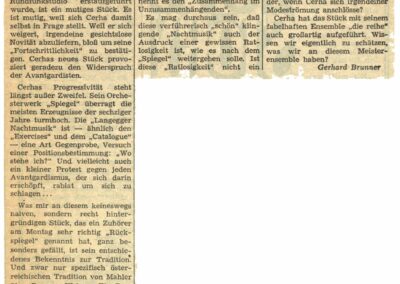Langegger Nachtmusik I
A Composed Environment
I. Keintate
Gschwandtner Tänze
View of the Danube Valley, Cerha’s private photo
This private Cerha family photograph shows part of the Danube region near Maria Langegg from above, probably at dusk.
Photo: The Archives of Contemporary Arts
„An old monastery, surrounded by a few houses, a densely wooded, scarcely populated, mountainous landscape south of the Wachau…“
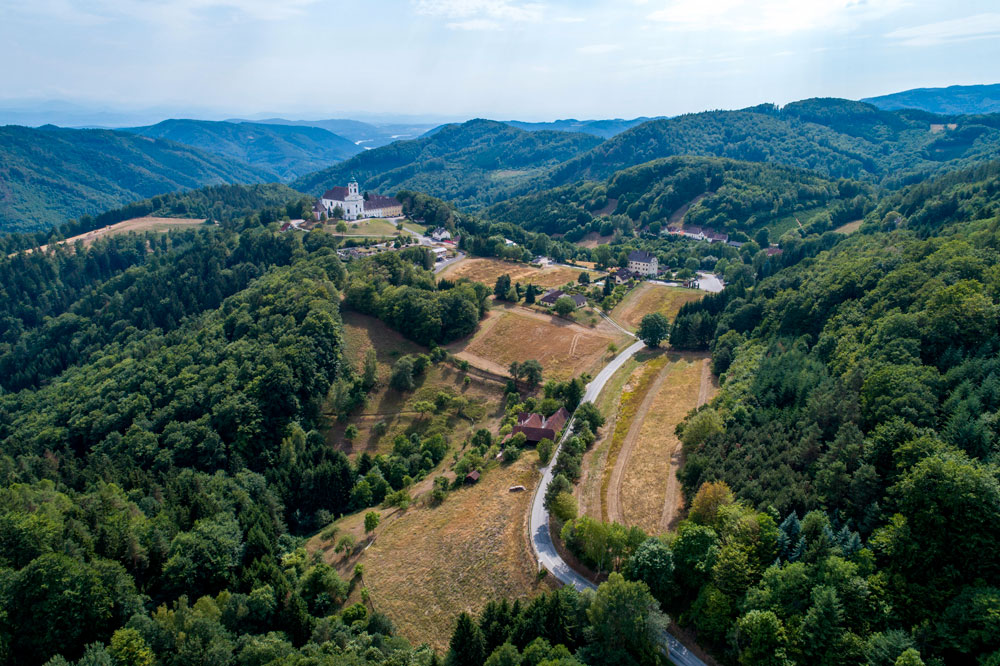
Maria Langegg, view to the east
Bildquelle: maria-langegg.at
Außenansicht
Brücke
The words “night music” call up a number of associations related to a genre steeped in history. „In the eighteenth century, ‘night music’ was for noble, festive pleasure, while in the nineteenth and twentieth centuries the nocturnal, demonic, ghostly, and bizarre gain in importance“Schriften: ein Netzwerk, Vienna 2001, p. 239, notes Cerha. Mozart’s Eine kleine Nachtmusik is a familiar example of the former meaning: It contains a serenade for strings, an entertaining evening music. Several stages of development lead up to the later, darkly shrouded meaning of the term. Cerha’s own chain of associations begins with E. T. A. Hoffmann, whose fantastical narrative cycle Nachtstücke (1815-17) provided the inspiration for several musical works of the same name. One also thinks of „Schumann, Chopin, Reger, Debussy, and above all […] of Mahler“.Cerha, Commentary on the three Langegger Nachtmusiken, AdZ, TEXT0007/6 whose Seventh Symphony inspired the name Langegger Nachtmusiken anregte.Cerha, Commentary on the three Langegger Nachtmusiken, AdZ, TEXT0007/11 In the symphony, the second and fourth movements are both called “Night Music”, while the eerie scherzo in between is titled “Shadowy”, the reason for the work’s subtitle “Song of the Night”. Gustav Mahler, the “namesake” for these pieces, also provides the key with which the door to the first Nachtmusik opens. Behind this door is an homage to the music history of Cerha’s home country—the one that shaped him most. “The Austrian music landscape”, says the composer about Langegger Nachtmusik I was „consciously awakened through allusions and then wiped away again, abandoned to destruction.“Schriften: ein Netzwerk, Vienna 2001, p. 239 In addition to Mahler, the work also suggests the personal styles of Alban Berg, Anton Webern, and György Ligeti—all composers with whom Cerha developed an intimate artistic relationship. The night as a musical theme gained importance in early twentieth-century Vienna, not only in Mahler’s Seventh Symphony (first performed in 1908). Nocturnal subjects also run through representative works of the Vienna School. Among them: The first of Alban Berg’s seven early songs (“Night”), Arnold Schönberg’s string sextet Verklärte Nacht, and the eighth piece from his melodramatic cycle Pierrot Lunaire (also titled “Night”). A concert recording from 1968, the approximate period in which Langegger Nachtmusik I was composed, makes the latter come alive under Cerha’s direction.
Arnold Schönberg, Pierrot Lunaire, „Nacht“
Ensemble „die reihe“, Ltg. Friedrich Cerha, Solistin: Marie-Thérèse Escribano, Palais Schönburg, Wien 1968
Anton Webern, Wolkennacht,
copied by Friedrich Cerha, AdZ, 000EA012/5
The tempi were very fast and hurried, the slow ones usually faster than intended, great value was placed on rhythmic precision and correct dynamics, but only little on phrasing and articulation, on the representation of the periodic. The ritardandi, so important for the formal structure, were performed so delicately that, in many cases, they could hardly be heard; fermatas and caesuras were only hinted at. All of this made it all too easy for formal analytical listening to turn into global structural listening, especially since the expressive presentation of individual elements was frowned upon as it emphasised some things above others, because it created contours whereas the musical events were supposed to be evenly distributed in space.
Friedrich Cerha
Schriften: ein Netzwerk, Vienna 2001, pp. 170 f.
As a conductor, Cerha committed himself to showcasing the expressiveness, emotion, and love for detail in Webern’s work. It became clear to him over time „how much the mental background of Webern’s music is rooted in the soil of Austrian life, the soil from which Schubert and Mahler and Berg also came and to which I feel I also belong.“Schriften: ein Netzwerk, Vienna 2001, p. 173 Without these conditions, Langegger Nachtmusik I would likely never have been created.
Innenansicht
Gertraud Cerha on Anton Webern
Interview with Maria Rennhofer in the TV series Österreichische Portraits, probably in the 1980s
The love for Anton Webern’s music, expressed here in an interview with Gertraud Cerha in the 1980s, is not merely central to understanding Cerha’s roots as a composer, it also illuminates the path to his first Nachtmusik piece. A glance at the instrumentation reveals a typical structure associated with Webern: a group of plucked strings and keyboard instruments that evoke a world of sound comprised of delicate, gentle colours, which are especially present in Webern’s Fünf Stücken für Orchester (Op. 10). This includes a harmonium, celesta, mandolin, guitar, and harp—plus five cowbells, which are also tucked away in Langegger Nachtmusik.
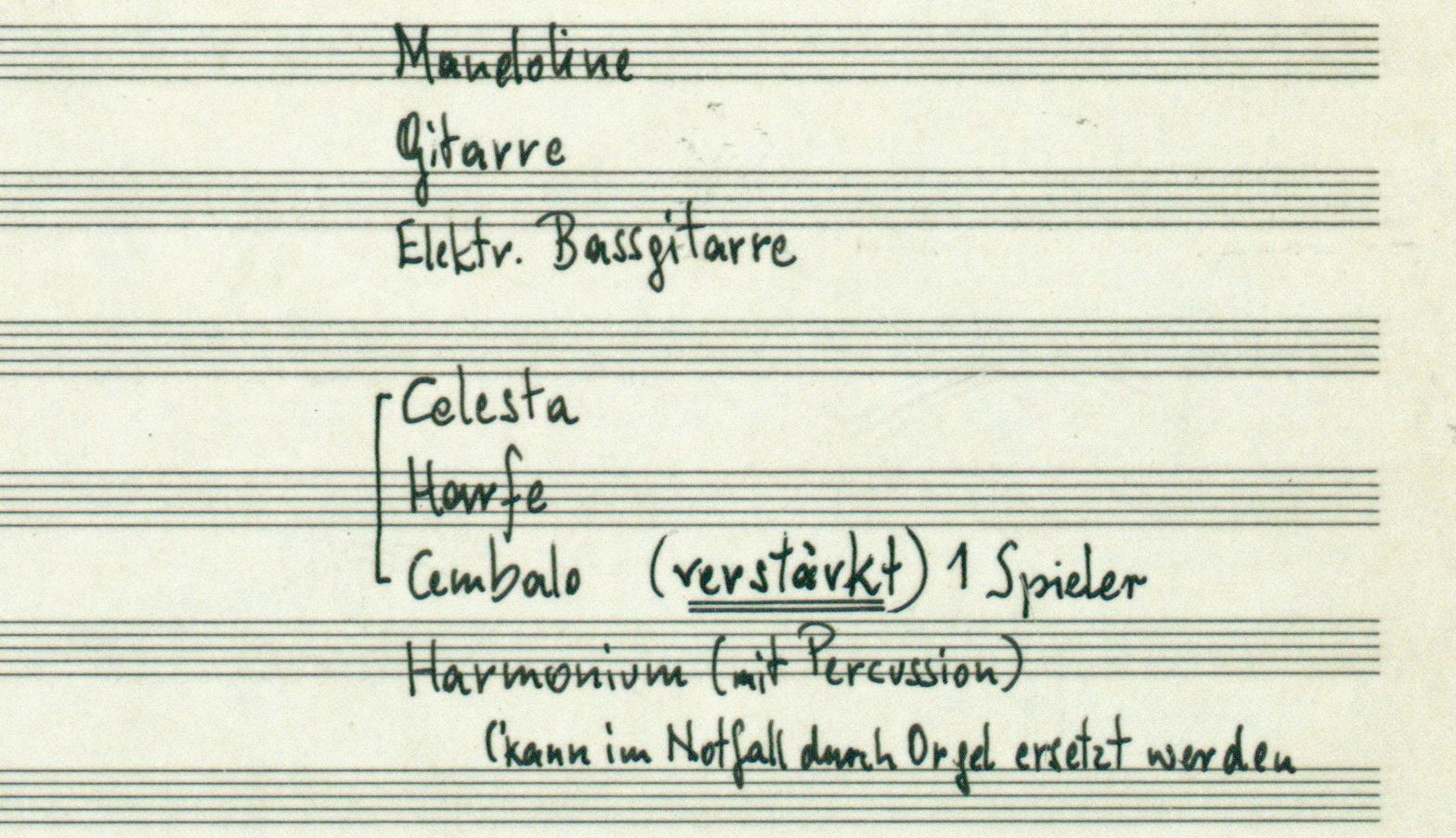
Cerha, Langegger Nachtmusik I, instrumentation, plucked strings and keyboard instruments, AdZ, 00000073/4
The mandolin and guitar are especially characteristic not only of Webern, but of the “Austrian musical landscape” as a whole, which Cerha explores in Nachtmusik. Both instruments appear in the penultimate movement (“Andante amoroso”) of the second Nachtmusik, working together as they weave an intimate world of sound. This plucked duo is similarly associated with another reference work of Austrian music history: Guitar and mandolin are also part of Arnold Schönberg’s Serenade (Op. 24) for seven instruments and a male voice. Cerha was particularly fond of the piece. Not only did he later consciously allude to Schönberg’s “evening music” in his 2006 work Serenade See Joachim Diederichs (ed.): Friedrich Cerha. Werkeinführungen, Quellen, Dokumente, Vienna 2018, p. 134 – he also transcribed portions of the sketches for the piece.
Arnold Schönberg, fragment in Serenade Op. 24, Cerha’s conducting score, bars 13–17, AdZ, 000EA08/18
Overall, Langegger Nachtmusik I belongs to a compositional phase that was inspired by an interest in the heterogeneous. In the 1950s and early 1960s, Cerha’s works were characterised by a limitation of means: Stylistically, they are uniform. Starting with Exercises showever, references to the distant musical past play an increasingly important role. Cerha’s approach is driven by a desire to no longer be guided by ideologies and absolutes:
I currently mistrust stylistic preoccupation and the barely changing repetition of my own and other people’s ideas over the last 30 years just as much as I do an uncontrolled facileness when choosing and approaching possible material. Nothing in my work can therefore currently be considered representative of a style and recipe for what is to come. Overly simple, primary materials and formulations are not enough for me to try out what interests me right now; and I mistrust the limits that unproven contemporary tastes would like to impose on me. What remains is my need for discriminating compositional connections
Friedrich Cerha
Schriften: ein Netzwerk, Vienna 2001, p. 237
For Cerha, the “discriminating compositional connections” refer to turning towards diversity without letting it become an end in itself. In Exercises the rapprochement to tradition occurs through the interactions of autonomous materials, with the possibilities becoming more mutually permeable in the compositions written from 1969 onwards. The option to directly cite and even imitate past musical spheres is left open. In the late 1960s, such processes were widespread, with musical collage on a triumphal march into the post-modern era. However, Cerha was not particularly interested in pure intermingling for its own sake. Instead of accentuating the divisions between what is different, the composer is interested in the „organic connection of the divergent.“Schriften: ein Netzwerk, Vienna 2001, p. 239 What new kind of unity can emerge from a mixture of dissimilar elements? This is a question that also interested Gustav Mahler and Anton Webern—and in them Cerha found a direction. He found „Webern’s approach to the format of the cycle“Schriften: ein Netzwerk, Vienna 2001, p. 239 greatly fascinating: “Different things, loosely joined to form a unity, rich diversity, merging into one.” Langegger Nachtmusik noticeably aligns itself with this ideal. Mahler’s credo of „using all the means of available technology to build a world“Herbert Killian (ed.): Gustav Mahler in den Erinnerungen von Natalie Bauer-Lechner, Hamburg 1984, p. 35 also comes into play. From banal folk melodies to powerful marches, or pathos to irony—all has a place in the composer’s symphonic cosmos. In the tension between coming together and drifting apart, between awakening and clearing awaySchriften: ein Netzwerk, Vienna 2001, p. 239 the imagined, Cerha’s philosophy unfolds in Nachtmusik.
Cerha, essay on Langegger Nachtmusik I, ca. 1969, AdZ, 000T0073/4
The listener encounters an expressive and ambiguous world that corresponds to this philosophy right at the outset. Cerha’s Nachtmusik opens with the almost improvised call of the flute floating in. The trilling flute melody is given structure by short, shimmering chords of several plucked and keyboard instruments and a glockenspiel, before the soundscape evaporates. This bundled energy is splintered into motivic fragments, all literally leading into the dark: The episode fades out in the form of low notes played by the harmonium and harp. The beginning of the piece makes it clear that this world of sound consists of snapshots that light up briefly, only to disappear into the shadows again. And it continues: First, individual bell sounds ring out, then lonely melodies emerge in an almost vacuum-like space, culminating in a mass of powerful striking chords. These put an end to the initial vaguely recognizable arc of suspense.

Cerha, Langegger Nachtmusik I, beginning
die reihe” ensemble, conducted by Friedrich Cerha, ORF Production 2001, Edition Zeitton
Dreamlike, at times even unreal, this first larger passage also suggests the sound codas of Austrian music history. These are merely „allusions“Schriften: ein Netzwerk, Vienna 2001, p. 239 and their presence is often deliberately blurred; the associative space is wide open. In the characteristic introduction, several things can be heard at the same time. Significantly, Anton Webern’s Acht Orchesterfragmente (1911/1913), which Cerha edited and performed with “die reihe”, joins the spinning of the carousel. The opening flute corresponds with the first of these fragments, with a similar ascendence arising from the solo violin.
The single chimes of Cerha’s Nachtmusik also have a counterpart in Webern’s “fragments”. In the fifth piece, which consists of only three bars, bell sounds peal out in a lonely soundscape. As with Cerha, the same three notes are struck, one after the other—Nachtmusik, however, uses different notes. The ringing, which in this largely silent environment seems to come from a distance, opens up other spaces of association. It is reminiscent of church bells at night, a sound from the real world—and, in fact, the bells of the pilgrimage church in Maria Langegg may have been one source of inspiration during the composition process.
Other vague references are loosely scattered throughout the introductory passage. For example, one can discover tiny splinters of sound that recall the gigantic cosmos of Mahler’s symphonies. A short, melodious mandolin and guitar fragment is reminiscent of the same instruments’ chirpings in Mahler’s second Nachtmusik. The deep, seemingly lost tonal figure of the harp, on the other hand, arouses associations with the archaic beginning of his ninth symphony, which is significant and singular in his universe: Instead of a powerful orchestral gesture, the music is fragmented at the beginning of the ninth. Only individual gestures, including the deep resonance of the harp, seep through like premonitions. The extremely subtle connections with Langegger Nachtmusik show that Cerha’s interest in fragmentary composition also corresponds with his interest in musical fragments of Austrian history. These can be briefly recognised in the gloam of Nachtmusik.
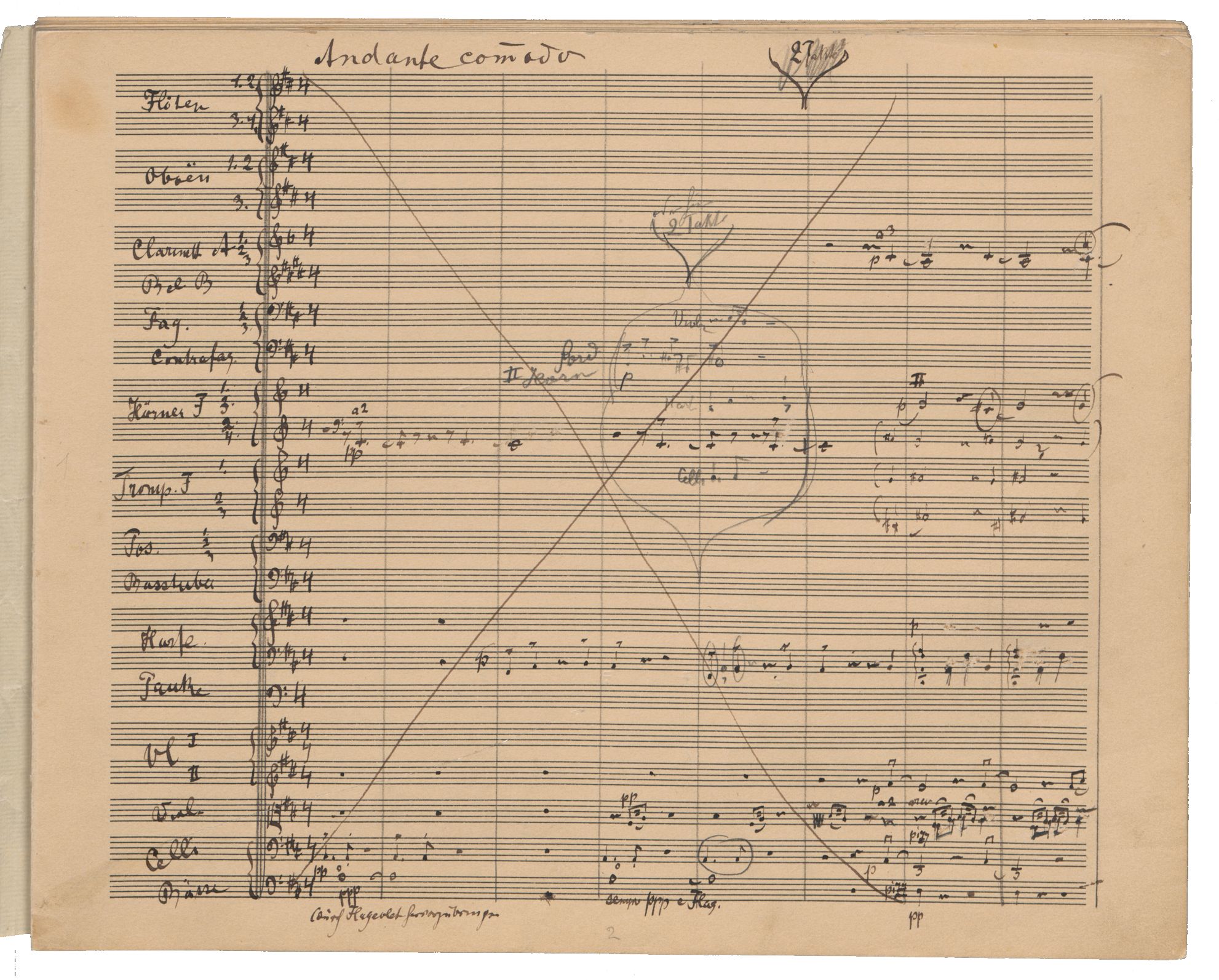
Gustav Mahler, Symphony No. 9, I. Andante comodo, handwritten score
Gustav Mahler, Sinfonie Nr. 9, beginning
Royal Concertgebouw Orchester, Ltg. Leonard Bernstein, Produktion Deutsche Grammophon 1990
As it continues, Langegger Nachtmusik often returns to the sound aura of the Webern cosmos, a cosmos “en miniature”, which also acts as a counterpart to the gigantism of Mahler’s world. One passage clearly stands out among the vague series of allusions, even approaching a direct quotation. Highly atmospheric harp and celesta circle around themselves in straightforward sound patterns, underpinned by five cowbells gently clinking in the background. A distant horn melody hangs above it all. Cerha drew this sound material from Webern’s Fünf Stücken für Orchester (op. 10). In the central third movement of the short pieces, „mountains and nature tamed by the instruments“Lothar Knessl, „Abseits vom Einerlei. Expressives Komponieren, österreichisch gefärbt“, in: Österreichische Musikzeitschrift 163/3 (2002), pp. 18–25, here p. 19 shimmer through. The similarity to the infinitely drawn out single beat of Cerha’s Nachtmusik is unmistakable.
Nachtmusik also reverberates with the younger layers of the “Austrian music landscape”. Over and over, nested sound fields flare up in brief fiery episodes, in some ways reminiscent of Cerha himself—or, more precisely, of the creative period in the early 1960s when he focused so intently on working with soundscapes. Meanwhile, there are also references to György Ligeti’s oeuvre—a connection that Cerha consciously emphasizes. Ligeti, an Austrian by choice, was in close contact with Cerha when the first Langegger Nachtmusik was written. Cerha prepared the world premiere of a new piece by his colleague, the Kammerkonzert for 13 instrumentalists, performed by “die reihe”, which is dedicated to Cerha and his ensemble. The two pieces, the Kammerkonzert and Langegger Nachtmusik, share a specific historical connection: Both premiered in Berlin in October 1970 (Kammerkonzert in a new version). Ligeti’s concert does not directly enter into the musical world of Nachtmusik—but a few of his signatures do flit through from time to time. An interlocking sound field in Cerha’s piece, for example, is reminiscent of the eccentric beginning of the Kammerkonzert.
Cerha, Langegger Nachtmusik I, T. 34 f.
Ensemble „die reihe“, Ltg. Friedrich Cerha, Produktion ORF, Edition Zeitton 2001
The musical compass of Cerha’s Nachtmusik points in many directions. „Sounds waft in as if from a night bedded down in nature“Lothar Knessl, „Abseits vom Einerlei. Expressives Komponieren, österreichisch gefärbt“, in: Österreichische Musikzeitschrift 163/3 (2002), pp. 18–25, here p. 21, notes Lothar Knessl. But exactly what direction the wind is blowing remains undefined: Maybe it is moving from inside to the outdoors, reflected in one’s own condensed memories and what is heard internally. But at times the flow also seems to move in the opposite direction, outside in, particularly towards the middle of the piece, when the „sound of ships on the Danube blowing their horns in the night“Schriften: ein Netzwerk, Vienna 2001, p. 239. can be heard against the quiet background of the strings. This unmistakable image is conveyed by the voices of solo wind instruments. The tension between nocturnal calm and the events that disrupt it increases and increases, conveying great power. The musical experience crystallizes into a shadowy world experience.“Reality […] mixes in with thoughts” Schriften: ein Netzwerk, Vienna 2001, p. 239, explains Cerha; the boundaries between fantasy and reality do not exist.

